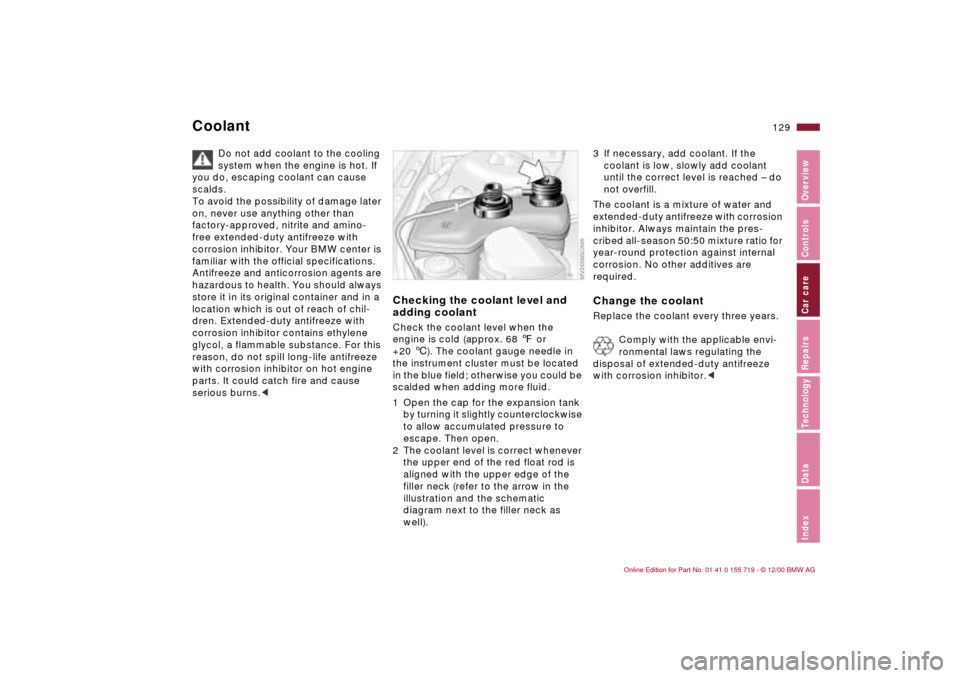Page 23 of 195
23n
IndexDataTechnologyRepairsCar careControlsOverview
Indicator and warning lampsGreen: for your information
Turn signal indicator
Flashes when the turn signal is
on. Rapid flashing indicates a
system malfunction.
For additional information, refer to
page 69.
Cruise control
Lights up when the cruise
control is activated: available for
operation via the multifunction steering
wheel.
For additional information, refer to
page 71.
Fog lamps
Comes on whenever you switch
on the fog lamps.
For additional information, refer to
page 85.
Blue: for your information
High beams
Comes on when the high beams
are on or the headlamp flasher
is actuated.
For additional information, refer to
pages 69, 85.
Page 69 of 195
69n
IndexDataTechnologyRepairsCar careControlsOverview
Turn signal indicator/Headlamp flasher Washer/Wiper system 1 High beams (blue indicator lamp)
2 Headlamp flasher (blue indicator
lamp)
3 Turn signal indicator (green indicator
accompanied by periodic clicking
sound from the relay).To signal brieflyPress the lever up to but not beyond
the detent. It then returns to the center
position when released.
When the turn signal indicator
lamp in the instrument cluster
flashes and the blinker relay clicks, a
turn indicator lamp has failed.<
0 Wipers retracted
1 Intermittent operation or rain sensor
*
2 Normal wipe
3 Fast wipe
4 Brief wipe
5 Rotary dial for controlling the wipe
interval or the sensitivity of the rain
sensor
*
Intermittent operation(not on vehicles with rain sensor)
You can set the wipe interval at four
stages with rotary dial 5. In addition, the
wipe interval is varied automatically
depending on road speed.
Page 74 of 195

74n
Fuel gauge Coolant temperature gauge Once the indicator lamp stays on
continuously, there are still approx.
2 gallons (8 liters) of fuel in the fuel
tank.
For fuel tank capacity, refer to
page 181.
If the tilt of the vehicle varies (extended
driving in mountainous areas, for
example), there may be slight fluctua-
tions of the needle.
Fill the fuel tank well before it is
empty. Driving to the last drop of
fuel can result in damage to the engine
and/or the catalytic converter.<
When the ignition is switched on, the
indicator lamp in the fuel display will
light up briefly to confirm that the
system is operational.
BlueThe engine is still cold. Drive at
moderate engine and vehicle speeds. RedTo confirm that the system is opera-
tional, the warning lamp in the coolant
temperature gauge will light up briefly
when the ignition is switched on.
If the lamp comes on while operating
the vehicle: the engine is overheated.
Stop and switch the engine off immedi-
ately and allow it to cool down.
Checking coolant level, refer to
page 129.
Between the blue and red zonesNormal operating range. It is not
unusual for the needle to rise as far as
the edge of the red zone in response to
high outside temperatures or severe
operating conditions.
Page 85 of 195
85n
IndexDataTechnologyRepairsCar careControlsOverview
High beams/Side marker lamps Fog lamps
1 High beams (blue indicator lamp)
2 Headlamp flasher (blue indicator
lamp)
3 Parking lampsSide marker lamps, left or rightAs an additional feature, you can illumi-
nate your vehicle on either side for
parking, if you wish to do so:
With the ignition key in position 0,
engage the lever in the appropriate turn
signal position.
Front fog lamps
A green indicator lamp appears
in the instrument cluster to indi-
cate that the front fog lamps are
on.
Page 129 of 195

129n
IndexDataTechnologyRepairsCar careControlsOverview
Coolant
Do not add coolant to the cooling
system when the engine is hot. If
you do, escaping coolant can cause
scalds.
To avoid the possibility of damage later
on, never use anything other than
factory-approved, nitrite and amino-
free extended-duty antifreeze with
corrosion inhibitor. Your BMW center is
familiar with the official specifications.
Antifreeze and anticorrosion agents are
hazardous to health. You should always
store it in its original container and in a
location which is out of reach of chil-
dren. Extended-duty antifreeze with
corrosion inhibitor contains ethylene
glycol, a flammable substance. For this
reason, do not spill long-life antifreeze
with corrosion inhibitor on hot engine
parts. It could catch fire and cause
serious burns.<
Checking the coolant level and
adding coolant
Check the coolant level when the
engine is cold (approx. 68 7 or
+20 6). The coolant gauge needle in
the instrument cluster must be located
in the blue field; otherwise you could be
scalded when adding more fluid.
1 Open the cap for the expansion tank
by turning it slightly counterclockwise
to allow accumulated pressure to
escape. Then open.
2 The coolant level is correct whenever
the upper end of the red float rod is
aligned with the upper edge of the
filler neck (refer to the arrow in the
illustration and the schematic
diagram next to the filler neck as
well).
3 If necessary, add coolant. If the
coolant is low, slowly add coolant
until the correct level is reached – do
not overfill.
The coolant is a mixture of water and
extended-duty antifreeze with corrosion
inhibitor. Always maintain the pres-
cribed all-season 50:50 mixture ratio for
year-round protection against internal
corrosion. No other additives are
required. Change the coolantReplace the coolant every three years.
Comply with the applicable envi-
ronmental laws regulating the
disposal of extended-duty antifreeze
with corrosion inhibitor.<